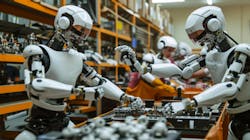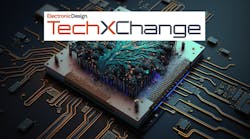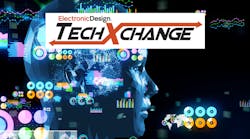Integrating AI into Robotics: The Fusion of Hardware and Software Design
What you’ll learn:
- How AI enhances robotic precision, accuracy, and ability to operate in dynamic environments.
- The role of AI in enabling autonomous robotic decision-making and adaptation.
- The ways that AI-powered robots can revolutionize workflows and collaborate with humans.
- Economic impacts include productivity gains and job displacement requiring retraining.
Historically, robots have been restricted by their pre-programmed nature, operating within a fixed set of parameters and unable to adapt to dynamic environments or make autonomous decisions. However, the combination of AI and robotics is shattering these limitations, paving the way for a new era of intelligent machines that can perceive, learn, and respond to complex situations with unprecedented precision and flexibility.
At the core of this transformation lies the convergence of cutting-edge AI algorithms and advanced robotic hardware. By harnessing the power of machine learning, computer vision, and natural-language processing, AI-enhanced robots can process vast amounts of data, recognize patterns, and make informed decisions in real-time. This collaborative relationship between hardware and software design opens up a world of possibilities, from streamlining manufacturing processes to exploring distant planets.
AI's Role in Enhancing Robotic Precision and Accuracy
Precision and accuracy are paramount in robotic operations, whether performing delicate surgical procedures, assembling complex machinery, or navigating hazardous environments. Even the slightest deviation can have severe consequences, highlighting the need for cutting-edge technologies to push the boundaries of robotics.
By integrating AI algorithms and machine-learning capabilities, robots can process vast amounts of sensor data with unparalleled speed and accuracy. Advanced computer-vision techniques enable robots to perceive their surroundings with granular detail, identifying objects, obstacles, and patterns that would be invisible to the human eye.
Moreover, AI-driven motion planning and control systems can calculate intricate trajectories and movements with consistency and exactitude, accounting for countless variables and minimizing the risk of errors. Sophisticated error detection and correction mechanisms further bolster accuracy, making it possible for robots to self-diagnose and rectify any deviations in real-time.
AI-Enabled Adaptability and Autonomous Decision-Making
While traditional robots excel at performing predefined tasks with unwavering consistency, their rigidity poses significant limitations in dynamic, unpredictable environments. This lack of adaptability has long been a bottleneck, hindering the full potential of robotic systems in sectors where agility and responsiveness are paramount.
>>Check out these TechXchanges for similar articles and videos
AI's integration into robotics obliterates this constraint, endowing machines with the remarkable ability to perceive, analyze, and respond to changing circumstances in real-time. Powered by advanced machine-learning algorithms and neural networks, AI-enhanced robots can continuously process data from their sensors, identifying patterns and making autonomous decisions to adapt their behavior accordingly.
Consider a search-and-rescue operation in a disaster zone. Conventional robots would be hamstrung by the unpredictable terrain and obstacles, unable to deviate from their programmed paths. In contrast, an AI robot could leverage computer vision and spatial awareness to navigate the treacherous landscape, identifying safe routes and making split-second decisions to avoid hazards or assist trapped individuals.
This level of adaptability extends far beyond physical environments. AI robots can also process vast amounts of data, discerning trends and making informed decisions to optimize workflows, streamline processes, and enhance collaboration with human counterparts. From manufacturing plants to healthcare facilities, this harmonious collaboration of human ingenuity and machine intelligence promises to unlock new realms of efficiency and productivity.
Transforming Workflows and Human-Robot Collaboration
Across industries, from manufacturing to healthcare to logistics, AI robots are poised to streamline processes, eliminate inefficiencies, and unlock new levels of productivity. Imagine fully automated production lines where intelligent robots can adapt to changes in demand, optimize material usage, and seamlessly reconfigure themselves without human intervention.
Moreover, integrating AI and robotics presents unprecedented opportunities for human-machine collaboration. Rather than replacing human workers, AI robots can augment their capabilities, acting as tireless assistants and force multipliers. In healthcare settings, surgical robots guided by AI could aid doctors in performing complex procedures with superhuman precision, minimizing risks and improving patient outcomes.
As we harness the power of AI-enhanced robotics, we are not merely automating tasks—we’re fundamentally transforming how we approach problem-solving and value creation. By seamlessly integrating the strengths of human ingenuity and machine intelligence, we can unlock new frontiers of productivity, efficiency, and innovation that were once unimaginable.
Economic Implications of AI-Enhanced Robotics
On the upside, AI-enhanced robotics promises significant productivity gains and cost savings across various sectors. A recent report estimates that by 2035, AI could boost labor productivity by up to 40% in certain industries. This increased efficiency translates to higher output, reduced production costs, and improved competitiveness for businesses that successfully leverage this technology.
However, this paradigm shift also raises concerns about job displacement, as AI robots may eventually replace human workers in certain roles. A 2017 study suggests that up to 38% of jobs in the U.S. are at risk of automation by the early 2030s.
This highlights the need for comprehensive workforce retraining and education initiatives to equip workers with the skills necessary to thrive in the new AI-driven landscape. More importantly, there hasn’t been recent data suggesting the same, which may imply that while AI will replace humans in certain jobs, it will spur the creation of entirely new industries and job categories.
A 2018 report by the World Economic Forum estimates that by 2025, AI could create 58 million new jobs globally—in fact, it already has created new jobs. These new opportunities will (and already have) revolve around the development, deployment, and maintenance of AI-robotic systems and roles that leverage human creativity and problem-solving abilities.
Ultimately, the responsible integration of AI into robotics hinges on our collective ability to embrace change, foster innovation, and prioritize ethical development. By doing so, we can harness the full potential of this groundbreaking collaboration that’s already happening. It will shape a future where humans and intelligent machines work in harmonious symbiosis, pushing the boundaries of what’s possible and ushering in a new age of technological progress.
>>Check out these TechXchanges for similar articles and videos
About the Author

Dev Nag
Founder & CEO, QueryPal
Dev Nag is the Founder/CEO at QueryPal. He was previously CTO/Founder at Wavefront (acquired by VMware) and a Senior Engineer at Google, where he helped develop the backend for all financial processing of Google ad revenue.
Before that, Dev served as the Manager of Business Operations Strategy at PayPal, where he defined requirements and helped select the financial vendors for tens of billions of dollars in annual transactions. He also launched eBay's private-label credit line in association with GE Financial.


